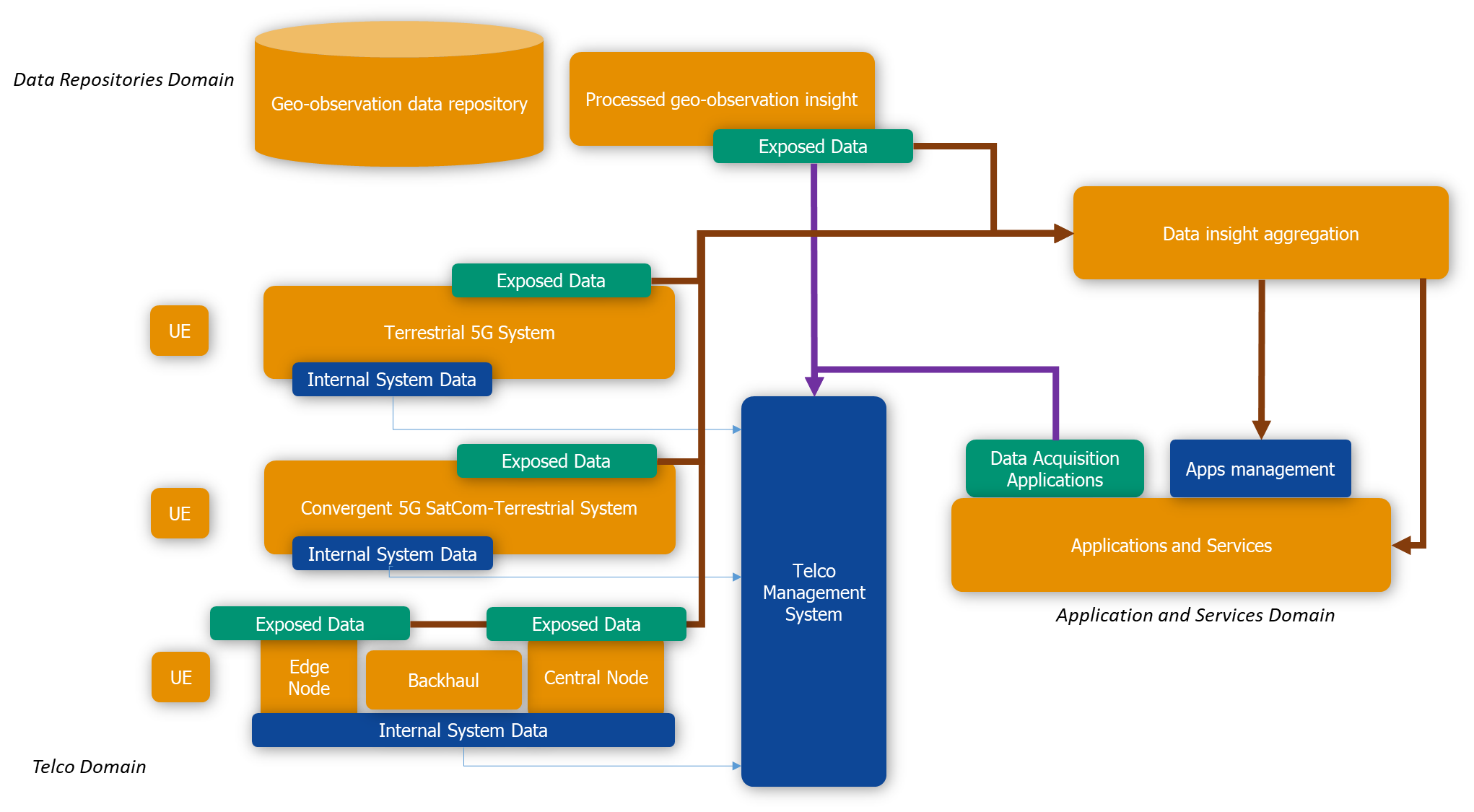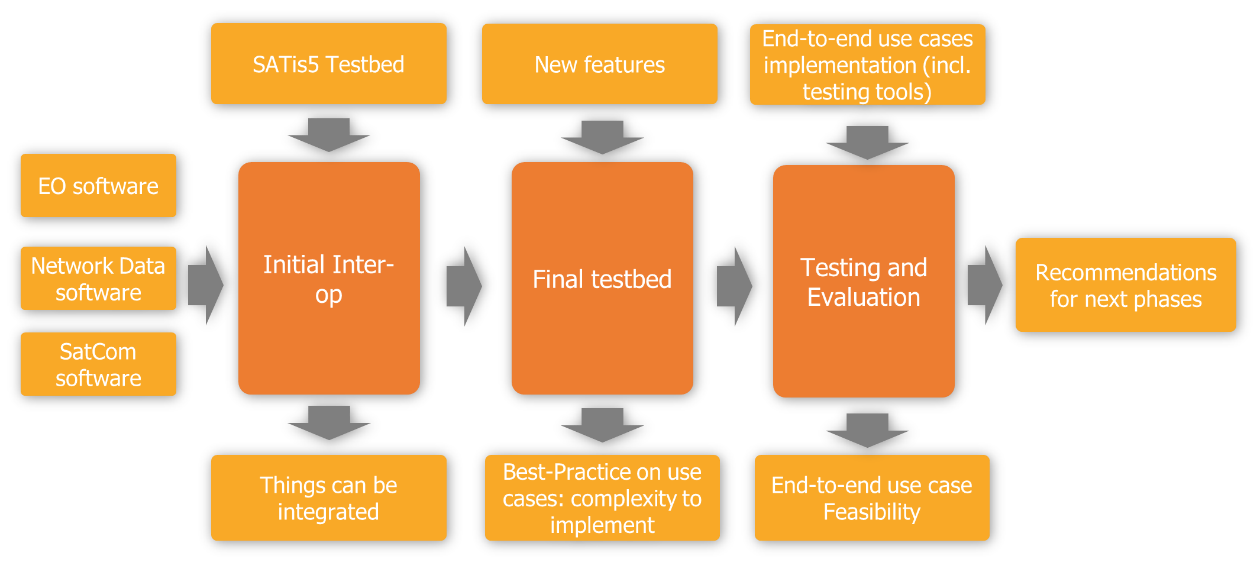
-
StatusCompleted
-
Status date2022-08-30
-
Activity Code1A.103
Expanse’s objective is to propose 5G native services leveraging on the development and deployment of SDN/VNF integrated SatCom terrestrial platforms, the use of Big Data, Cloud and Multiple access Edge Computing.
As part of this objective Expanse devises a new approach to tackle the overall lifecycle of 5G native services’ design, development and orchestration for different verticals in an integrated SatCom terrestrial 5G ecosystem, adopting the principles of cloud-native services and the separation of concerns among the orchestration of the developed vertical services/applications and the necessary underlying transport network services that support them.
The challenge of Expanse lies in its exploratory nature intending to bring competencies and areas closer together.
Expected benefits of Expanse include the identification of opportunities exploiting the wealth of data inherently available from the highly distributed SatCom user base, where applicable to market verticals. Information on geographic distribution, temporal usage patterns, user mobility, and link performance can be evaluated to infer broader or underlying trends, as already used in other telecommunication networks. Inward looking uses include improving Quality of Service, reducing customer churn, and capacity reassignment, with additional possibilities to monetise data for external applications, such as localised weather and traffic information.
Expanse explores the usability of micro-services architectures, lightweight virtualisation open source technologies and monitoring tools to set up and effectively run the deployment of 5G native distributed services and to effectively process and interface with big data sources repositories at different sites.
A basic concept of Expanse is the concept of data-chains or data-processing-chains (somewhat similar to service chains). Expanse focuses on end-to-end chains on which data is acquired, processed and used across the different domains. We would like to highlight two such chains as follows:
Chain 1: Optimization of the 5G system behaviour
-
use of the satellite network within the 5G system to provide additional monitoring information for a better management of the overall system;
-
use of insight from geo-observation data to optimize the usage of the 5G system – geo-observation data can be used by the 5G system management in order to be able to optimize its behaviour.
Chain 2: optimization of the applications and of the applications’ behaviour by combining status information available in the convergent 5G satellite-terrestrial environment with geo-observation data.
The envisaged high-level architecture of the combined big data / EO data and telco management system is as follows:

In our approach, we postulate the convergence of the different administrative and technical domains at the data level, including:
-
Big Data Repositories Domain
-
Telco Domain
-
Terrestrial 5G System
-
Converged SatCom-Terrestrial 5G System
-
Edge-Central System
-
-
Application and services domain
Expanse considers data from multiple sources, including earth observation, network management and devices and sensor data as inputs for a data processing layer which in turn enables the increase of the network adaptation capabilities as well as of the application level data enhancement.

A high-level overview of the role of Expanse
The data processing layer includes the functionality related to the:
-
Data discovery and access – providing the mechanisms for how the different sources of data can be found and how the data can be accessed;
-
Efficient and secure data exchange – especially concentrating on the reduction of network resources consumption as well as on the secure end-to-end connectivity;
-
Data pre-processing – addressing the need of coherence in data retrieved from the different data sources;
-
Data Insight generation – addressing the opportunities brought by different statistics and machine learning mechanisms to generate additional knowledge from data.
In Expanse the different aspects are addressed only in an initial form while implementing and validating a limited set of end-to-end use cases. Our approach helps to identify additional aspects warranting further study, but at the same time already provide initial results concerning real-life use cases.
The Expanse activity consists of three phases, each of them concluding with a milestone review meeting. The short, three month long initial phase assesses 5G vertical services and big data, and ends with a preliminary review. The second phase continues with establishing a framework and devising a reference architecture, and specifying service orchestration and design concluding with a design review. Finally, the third and last phase caters for the development, verification and validation as well as wrapping up the activity with conclusions and recommendations and concludes with the final review.

The Expanse project has completed successfully.
The project identified and assessed opportunities exploiting the wealth of data inherently available from the highly distributed SatCom user base, where applicable to market verticals. The project has considered data from multiple sources, including Earth Observation, network management and devices and sensor data as inputs for a data processing layer. The devised data processing layer enables the increase of the network adaptation capabilities as well as of the application-level data enhancement.
Expanse addressed a wide range of aspects, albeit only in an initial form while implementing and validating a limited set of end-to-end use cases. The three use cases selected and pursued in Expanse were:
-
SatCom antenna position optimisation
-
Disaster management/prevention
-
Influence of weather on communication
This approach helped us to identify additional aspects warranting further study, but provided important initial results concerning real-life use cases.





